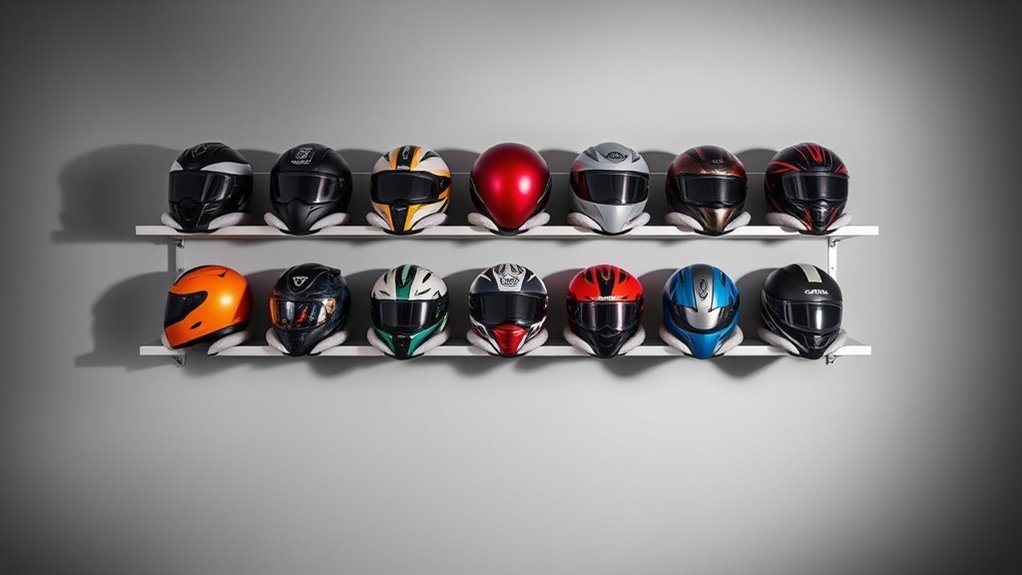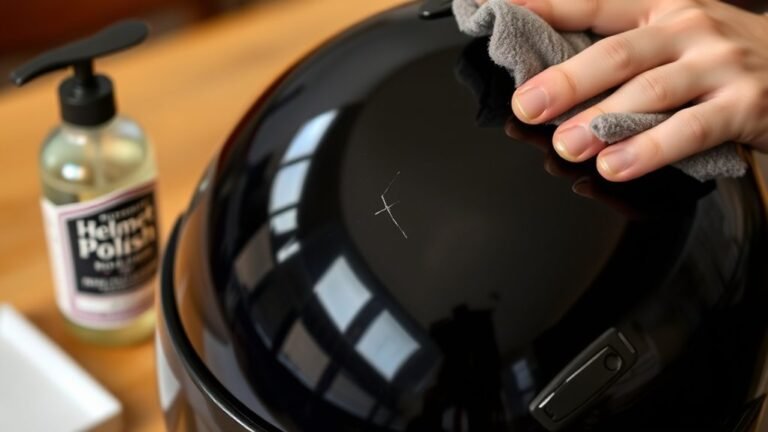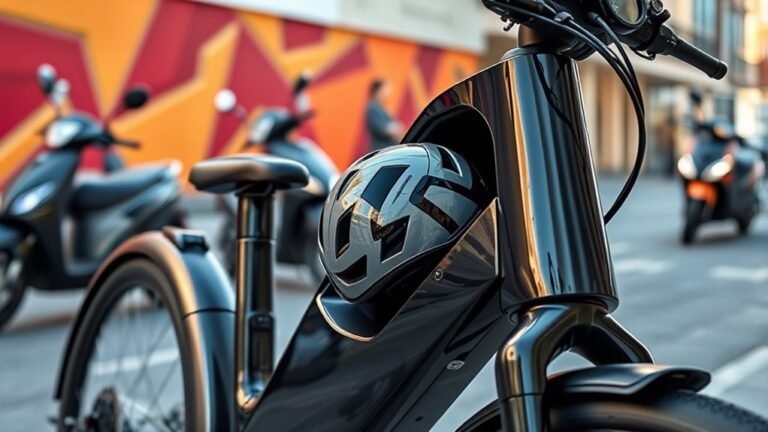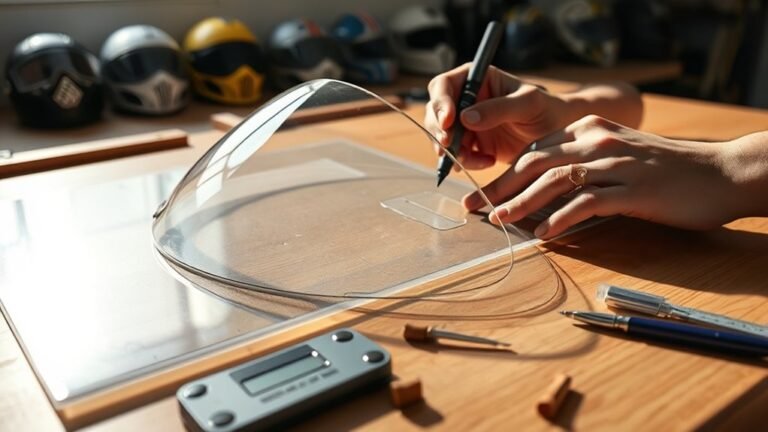How to Store Multiple Helmets Without Damage
To store multiple helmets without damage, choose a cool, dry location away from direct sunlight and heat sources. Use helmet racks or organizers to keep them secure and accessible, as these prevent scratches and bumps. Consider DIY solutions like wooden shelves or PVC pipe holders for a unique touch. Don’t forget protective measures like helmet bags and monthly inspections for wear. By following these tips, you’ll guarantee your helmets stay in top condition for future adventures. More details are coming up!
Choosing the Right Storage Location
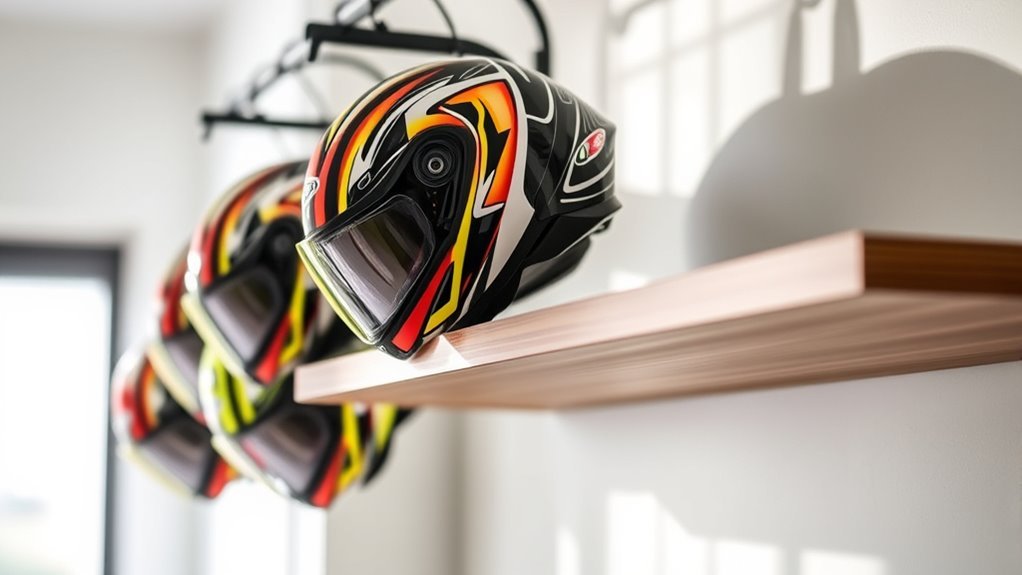
When it comes to storing your helmets, choosing the right location is essential to guarantee their longevity and maintain safety standards. Consider suitable environments carefully; indoor storage is often preferable. A cool, dry closet or a dedicated shelf protects helmets from extreme temperatures and moisture, which can compromise their integrity. Avoid placing them in direct sunlight or near heat sources, as these conditions weaken materials over time.
If you must store helmets outdoors, make certain they’re in a shaded, weatherproof area, away from humidity and temperature fluctuations. Remember, the right location not only preserves your helmets but also keeps them ready for your next adventure, allowing you to embrace freedom without worrying about safety.
Utilizing Helmet Racks and Organizers

While you can store helmets in various ways, utilizing helmet racks and organizers offers a practical solution that enhances both accessibility and protection. Helmet wall mounted options provide an effective way to showcase your collection while keeping them safe from damage. These racks often come with customizable features, allowing you to arrange your helmets according to your style.
When choosing helmet display options, consider materials that won’t scratch or dent your helmets. Look for racks that keep helmets securely in place, preventing them from falling or getting bumped. This not only protects your investment but also makes grabbing a helmet quick and easy when you’re ready for your next adventure. Embrace the freedom of organized storage with the right helmet rack!
DIY Helmet Storage Solutions
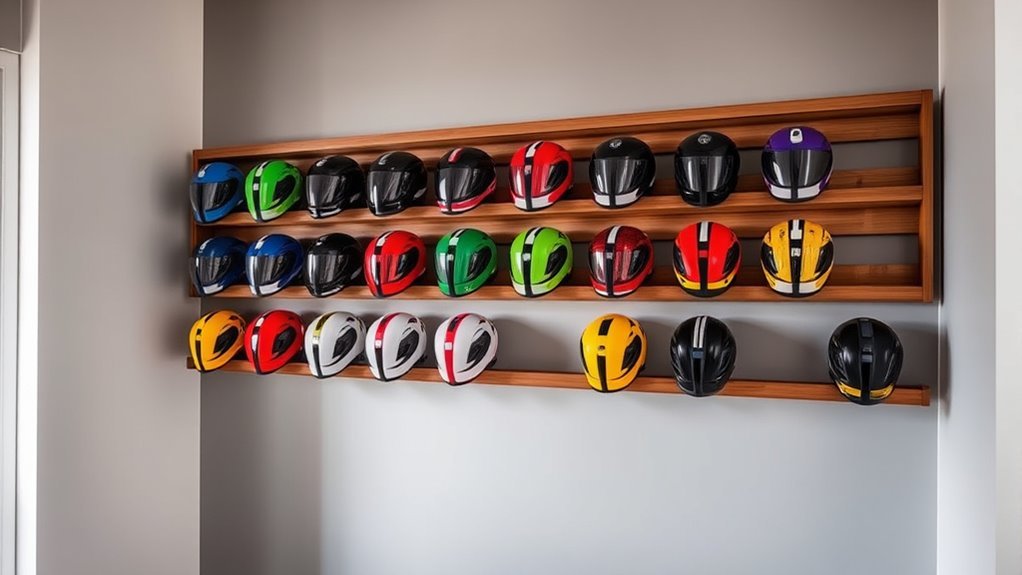
If you’re looking to take on a project that combines creativity and functionality, DIY helmet storage solutions can be a rewarding way to keep your gear organized. Crafting custom shelving or using wall mounts not only showcases your helmets but also keeps them safe from damage. Here are four ideas to inspire your project:
- Wooden Shelf Rack: Build a sturdy wooden shelf to display helmets like trophies.
- PVC Pipe Holders: Use PVC pipes to create a unique and affordable helmet holder.
- Magnetic Wall Mounts: Install magnetic mounts for easy access and a sleek look.
- Repurposed Crates: Transform old crates into stylish helmet storage with character.
These solutions let you express your style while ensuring your helmets are always ready for your next adventure.
Protective Measures for Long-Term Storage
To guarantee your helmets remain in top condition during long-term storage, it is essential to take protective measures that shield them from environmental damage and deterioration. Start by ensuring proper humidity control and temperature regulation in your storage area. Use a dehumidifier to maintain consistent humidity levels and avoid mold growth.
Here’s a quick reference table to help:
| Protective Measure | Purpose |
|---|---|
| Dehumidifier | Controls humidity levels |
| Temperature Monitor | Keeps track of temperature |
| Helmet Bag | Prevents scratches and dust |
| Ventilated Container | Allows airflow, reducing moisture |
Implementing these measures will help preserve your helmets, ensuring they’re ready for freedom when you are!
Regular Maintenance and Inspection Tips
Regular maintenance and inspection of your helmets are essential, as it not only extends their lifespan but also guarantees your safety during use. To keep your helmets in top shape, follow these important tips:
Regular helmet maintenance is crucial for safety and longevity; follow essential tips to keep them in top shape.
- Inspect regularly: Check your helmets at least once a month for cracks or signs of wear.
- Use proper cleaning techniques: Clean the outer shell with mild soap and water, avoiding harsh chemicals that can damage materials.
- Examine the interior: Look for padding deterioration; replace any damaged liners or foam.
- Store correctly: Ensure helmets are stored in a cool, dry place, away from direct sunlight to prevent material degradation.
Frequently Asked Questions
Can I Stack Helmets to Save Space?
You might think stacking helmets could save space, but it’s a slippery slope. Helmets are like fragile treasures; one wrong move and they could be damaged. Instead of stacking, consider a helmet organization system that keeps each one in its own cozy nook. Use shelves or hooks to display them like art, ensuring they stay safe and sound. This way, you’ll protect your gear while creating a stylish storage solution that breathes freedom into your space.
What Materials Should I Avoid for Helmet Storage?
You should avoid materials that trap moisture, like plastic bags or cardboard, which can lead to mold growth. Instead, opt for breathable fabrics. Also, steer clear of areas with extreme temperature fluctuations, as metal or uninsulated storage can affect your helmet’s integrity. Use materials that offer moisture control and temperature stability, ensuring your helmets stay in prime condition. This way, you can keep your gear safe and ready for your next adventure!
How Often Should I Replace My Helmet?
You should replace your helmet every three to five years, even if it seems fine. For instance, a cyclist named Jenna noticed her helmet had scratches after a few falls; she realized it was time for an upgrade. Regular helmet maintenance is essential for helmet safety. Over time, materials degrade, compromising protection. Always check for visible damage and replace helmets after any significant impact to guarantee you’re riding safely and confidently.
Is It Okay to Store Helmets in Direct Sunlight?
No, it’s not okay to store helmets in direct sunlight. UV damage can weaken the materials and compromise their safety. Heat exposure can also distort the shape and integrity of the helmet. To guarantee your helmet stays in top condition, keep it in a cool, shaded area, away from direct sunlight. Consider using a storage bag or box that protects it from light and heat, so you can enjoy your freedom without worry.
Do Helmets Have an Expiration Date?
Yes, helmets do have an expiration date, usually around five to seven years. Think of them as a trusty steed—great at first but eventually wearing down. Over time, the materials degrade, compromising your safety. It’s essential to check the manufacturer’s guidelines and safety standards to guarantee your helmet’s still up to the task. If you want freedom on the road, don’t ride with outdated gear; prioritize your safety!
